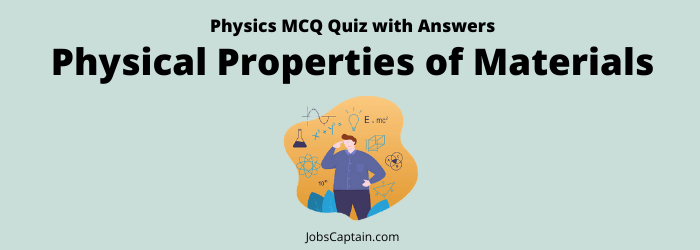
Question 1. The tendency of a liquid drop to contract and occupy minimum area is due to?
(A) Vapour pressure
(B) Density
(C) Viscosity
(D) Surface tension
Question 2. The most important property of nanomaterial is __________.
(A) Temperature
(B) Pressure
(C) Friction
(D) Force
Question 3. Spherical form of raindrop is due to ___________.
(A) Gravitational force
(B) Atmospheric pressure
(C) Surface tension
(D) Density of liquid
Question 4. The rain drops are spherical because _________.
(A)They fall from big height
(B) The water has surface tension
(C) The air has resistance
(D) None of the above
Question 5. Oil spreads on water surface because ____________.
(A) Surface tension of oil is less than water
(B) Surface tension of oil is more than water
(C) Oil is less dense than water
(D) Oil is denser than water
Question 6. Kerosene oil floats on water because ____________.
(A) Its density is greater than the density of water
(B) Its density is equal to that of the density of water
(C) Its density is less than the density of water
(D) None of the above
Question 7. Pressure inside a soap bubble is __________.
(A) Half of atmospheric pressure
(B) Equal to atmospheric pressure
(C) Less than atmospheric pressure
(D) More than atmospheric pressure
Question 8. If two bubbles of soap of different diameter come in contact with a tube, then what will happen?
(A) Both bubbles will burst as soon as they come in contact
(B) The smaller bubble will become larger and larger will become smaller to get the same size
(C) The smaller bubble will become smaller and bigger will become bigger
(D) The size of both the bubbles will remain same
Question 9. The size of the Respirable Suspended Particulate Matter (R.S.P.M.) in air is _________.
(A) less than 5mm (micron)
(B) more than 5mm (micron)
(C) more than 6mm (micron)
(D) more than 7mm (micron)
Question 10. Four wires of same material and dimensions as mentioned below are stretched by a load of same magnitude separately. Which one of them will be elongated maximum?
(A) Wire of 1 m length and 1 mm diameter
(B) Wire of 3 m length and 1.5 mm diameter
(C) Wire of 2 m length and 2 mm diameter
(D) Wire of 1 m length and 2 mm diameter
Question 11. The density of water will reach its maximum value at the temperature of _________.
(A) 100ºC
(B) 50ºC
(C) 4ºC
(D) 0ºC
Question 12. If an unsaturated sugar solution is prepared by mixing 100 grams of sugar with half litre of water, which of the following physical quantities will not change?
(A) Volume
(B) Concentration
(C) Density
(D) Mass
Question 13. Increasing the amount of a substance does not change its ___________.
(A) Density
(B) Mass
(C) Weight
(D) Volume
Question 14. Fish can survive in a frozen lake because __________.
(A) Ice is a good conductor of heat
(B) Water near the bottom does not freeze
(C) Fish hibernate in ice
(D) Fish are warm blooded animals
Question 15. In cold weather, aquatic animals survive even when water at the top layer of the lake freezes into ice because?
(A) Water has the highest density at 4ºC so underneath the top layer of ice there is a layer of water
(B) Their body structure is such that they can survive without oxygen
(C) They have enough of accumulated oxygen inside them
(D) They can breathe in ice
Question 16. The surface of a lake is frozen in severe winter, but the water at its bottom is still liquid. Why?
Following are some options
(A)Ice is a bad conductor of heat
(B) The density of water is maximum at 4ºC
(C) Since, the surface of the lake is at the same temperature as the air, no heat is lost
(D) None of the above
Question 17. Which of the following is the byproduct derived from the refining process of petroleum?
(A) Asphalt
(B) Coal
(C) Charcoal
(D) Petrol
Question 18. A sudden fall in barometer reading indicates that the weather will be _________.
(A) Hot and humid weather
(B) Cool dry weather
(C) Rainy weather
(D) Stormy weather
Question 19. In automobile hydraulic brakes work on __________.
(A) Pascal’s Law
(B) Bernoulli’s Principle
(C) Newton’s law of motion
(D) Archimedes Principle
Question 20. While travelling by plane, the ink of the pen starts to come out?
(A) Due to excessive load
(B) Due to increase in volume of ink
(C) Due to increase in air pressure
(D) Due to decrease in air pressure
Question 21. When an air bubble at the bottom of lake rises to the top, it will?
(A) Flatten into a disc like shape
(B) Maintain its size
(C) Decreased in size
(D) Increased in size
Question 22. In a capillary tube a fluid rises more as compared to water, it is due to?
(A) Surface tension of fluid is more than that of water
(B) Surface tension of fluid is less than that of water
(C) Temperature of fluid is more than that of water
(D) Fluid is more viscous than that of water
Question 23. Kerosene rises in the wick of the stove is due to __________.
(A) Biogen contraction
(B) Surface tension
(C) Diffusion
(D) Osmosis
Question 24. With the rise of temperature, the viscosity of liquid?
(A) May increase or decrease
(B) Remains unchanged
(C) Decreases
(D) Increases
Question 25. For which one of the following capillarity is not the only reason?
(A) Rising of water from the roots of a plant to its foliage
(B) Spread of water drop on a cotton cloth
(C) Rising of underground water
(D) Blotting of ink
